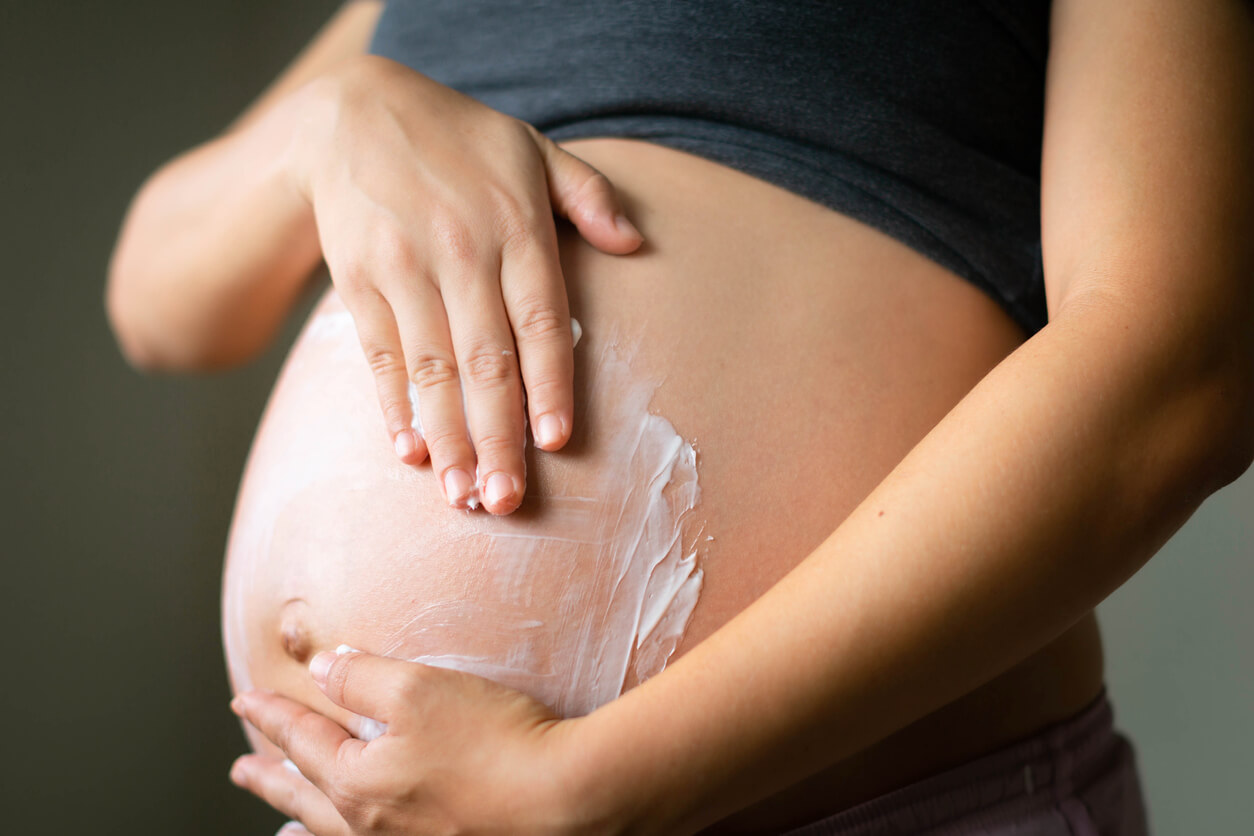Anti-Stretch Mark Routine During Pregnancy


Written and verified by the dermatologist Maria del Carmen Hernandez
A correct anti-stretch mark routine during pregnancy is very important in order to keep the skin of the body healthy and undamaged. It’s one of the aesthetic problems that most arouse interest in the stage of pregnancy.
Although they’re not a serious skin condition, they can have a negative impact on psychosocial aspects and the self-esteem of those who suffer from stretch marks. For this reason, we’ll detail an anti-stretch mark routine to use during pregnancy.
Why do stretch marks occur?
Stretch marks are atrophic linear scars that can cause distress and concern in women. As a result, they can diminish the quality of life. They’re manifested by the loss and partial rupture of elastin and collagen fibers in the affected area.
Therefore, there’s a marked loss of cohesion in the skin as it can’t tolerate the tensile forces of the muscles that support it. The vast majority of causes include the following:
- Genetic factors
- Mechanical stress on the connective tissue
- Hormonal factors (estrogen and progesterone)
Read also: 10 Interesting Facts About Your Skin When You’re Pregnant

Learn what an anti-stretch mark routine during pregnancy looks like
The fact that stretch marks during pregnancy are a major concern for women is reflected in the use of products for their prevention or to reduce their severity. It’s best to develop an anti-stretch mark routine because they’re very difficult to remove once they’ve already appeared on the skin.
Bath and care
It’s important to apply emollients or body oils after showering or bathing. This is the time when the pores of the skin surface are more dilated and absorb the active ingredients more effectively. In addition, essential oils are also effective to fulfill this function because in their composition they have elements that stimulate elasticity and collaborate with the progressive changes of the body.
Another recommendation to put into practice is to perform circular massages during the shower to stimulate the circulatory system. The correct products should also be used so as not to damage the skin’s natural protective layer. However, it’s estimated that between 50% and 90% of pregnant women will develop stretch marks during pregnancy.
Exfoliation
Exfoliation is one of the most important procedures to contribute to the renewal of the most superficial layers. For this reason, this anti-stretch mark routine shouldn’t be abandoned during pregnancy. In addition to helping with the removal of dead cells, it facilitates the absorption of moisturizing products or active substances applied to the skin.
It’s best to opt for products that aren’t too abrasive and irritating to the sensitive skin of pregnant women. Therefore, natural exfoliants with fine granules are an excellent choice.
On the contrary, chemical exfoliants may be too aggressive to be used during this period of a woman’s pregnancy. Consequently, trichloroacetic acid, phenol, and salicylic acid should be postponed until after delivery.
You may be interested in: Skin Exfoliation During Pregnancy: Everything You Need to Know

Moisturizing
Many over-the-counter emollients and cosmetics are marketed and used by pregnant women to prevent stretch marks or reduce their severity. In fact, much of their effectiveness lies in the frequency and regularity of their use.
There is proven evidence of the effectiveness of anti-stretch mark moisturizers containing rosehip oil, hydroxyprolisilane C, centella asiatica, and vitamin E.
Hydration and nutrition
Drinking enough fluids per day contributes to maintaining smooth, hydrated skin. Even the liquids contained in fruits, soft drinks, and herbal teas are taken into consideration. Food is also essential to keeping all the body’s functions vital during pregnancy. Therefore, a proper diet should contain vitamin C, vitamin D, vitamin E, zinc, and protein.
Vitamin C, which is found in vegetables and fruits, is one of the most important nutrients for the development of collagen and the maintenance of elastic and strong skin. In order to be sure to get the right variety of nutrients, foods of all colors should be chosen.
Preventing stretch marks during pregnancy
Preventing stretch marks in women during pregnancy is as important as the choice of product for the same purpose. In addition, they can have both physical and psychological implications.
The use of prophylactic measures such as skin oils and emollients, with the appropriate frequency of use, significantly reduces the risk of developing stretch marks during pregnancy.
A correct anti-stretch mark routine during pregnancy is very important in order to keep the skin of the body healthy and undamaged. It’s one of the aesthetic problems that most arouse interest in the stage of pregnancy.
Although they’re not a serious skin condition, they can have a negative impact on psychosocial aspects and the self-esteem of those who suffer from stretch marks. For this reason, we’ll detail an anti-stretch mark routine to use during pregnancy.
Why do stretch marks occur?
Stretch marks are atrophic linear scars that can cause distress and concern in women. As a result, they can diminish the quality of life. They’re manifested by the loss and partial rupture of elastin and collagen fibers in the affected area.
Therefore, there’s a marked loss of cohesion in the skin as it can’t tolerate the tensile forces of the muscles that support it. The vast majority of causes include the following:
- Genetic factors
- Mechanical stress on the connective tissue
- Hormonal factors (estrogen and progesterone)
Read also: 10 Interesting Facts About Your Skin When You’re Pregnant

Learn what an anti-stretch mark routine during pregnancy looks like
The fact that stretch marks during pregnancy are a major concern for women is reflected in the use of products for their prevention or to reduce their severity. It’s best to develop an anti-stretch mark routine because they’re very difficult to remove once they’ve already appeared on the skin.
Bath and care
It’s important to apply emollients or body oils after showering or bathing. This is the time when the pores of the skin surface are more dilated and absorb the active ingredients more effectively. In addition, essential oils are also effective to fulfill this function because in their composition they have elements that stimulate elasticity and collaborate with the progressive changes of the body.
Another recommendation to put into practice is to perform circular massages during the shower to stimulate the circulatory system. The correct products should also be used so as not to damage the skin’s natural protective layer. However, it’s estimated that between 50% and 90% of pregnant women will develop stretch marks during pregnancy.
Exfoliation
Exfoliation is one of the most important procedures to contribute to the renewal of the most superficial layers. For this reason, this anti-stretch mark routine shouldn’t be abandoned during pregnancy. In addition to helping with the removal of dead cells, it facilitates the absorption of moisturizing products or active substances applied to the skin.
It’s best to opt for products that aren’t too abrasive and irritating to the sensitive skin of pregnant women. Therefore, natural exfoliants with fine granules are an excellent choice.
On the contrary, chemical exfoliants may be too aggressive to be used during this period of a woman’s pregnancy. Consequently, trichloroacetic acid, phenol, and salicylic acid should be postponed until after delivery.
You may be interested in: Skin Exfoliation During Pregnancy: Everything You Need to Know

Moisturizing
Many over-the-counter emollients and cosmetics are marketed and used by pregnant women to prevent stretch marks or reduce their severity. In fact, much of their effectiveness lies in the frequency and regularity of their use.
There is proven evidence of the effectiveness of anti-stretch mark moisturizers containing rosehip oil, hydroxyprolisilane C, centella asiatica, and vitamin E.
Hydration and nutrition
Drinking enough fluids per day contributes to maintaining smooth, hydrated skin. Even the liquids contained in fruits, soft drinks, and herbal teas are taken into consideration. Food is also essential to keeping all the body’s functions vital during pregnancy. Therefore, a proper diet should contain vitamin C, vitamin D, vitamin E, zinc, and protein.
Vitamin C, which is found in vegetables and fruits, is one of the most important nutrients for the development of collagen and the maintenance of elastic and strong skin. In order to be sure to get the right variety of nutrients, foods of all colors should be chosen.
Preventing stretch marks during pregnancy
Preventing stretch marks in women during pregnancy is as important as the choice of product for the same purpose. In addition, they can have both physical and psychological implications.
The use of prophylactic measures such as skin oils and emollients, with the appropriate frequency of use, significantly reduces the risk of developing stretch marks during pregnancy.
All cited sources were thoroughly reviewed by our team to ensure their quality, reliability, currency, and validity. The bibliography of this article was considered reliable and of academic or scientific accuracy.
- Rawlings AV, Bielfeldt S, Lombard KJ. A review of the effects of moisturizers on the appearance of scars and striae. Int J Cosmet Sci. 2012 Dec;34(6):519-24. doi: 10.1111/j.1468-2494.2012.00751.x. Epub 2012 Sep 21. PMID: 22994859.
- García Hernández JÁ, Madera González D, Padilla Castillo M, Figueras Falcón T. Use of a specific anti-stretch mark cream for preventing or reducing the severity of striae gravidarum. Randomized, double-blind, controlled trial. Int J Cosmet Sci. 2013 Jun;35(3):233-7. doi: 10.1111/ics.12029. Epub 2013 Jan 15. PMID: 23237514.
This text is provided for informational purposes only and does not replace consultation with a professional. If in doubt, consult your specialist.








